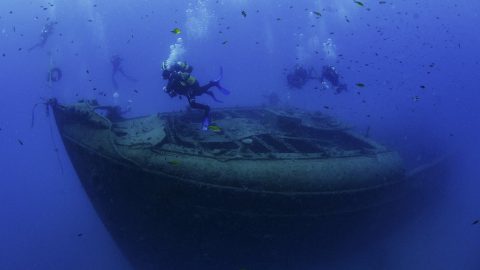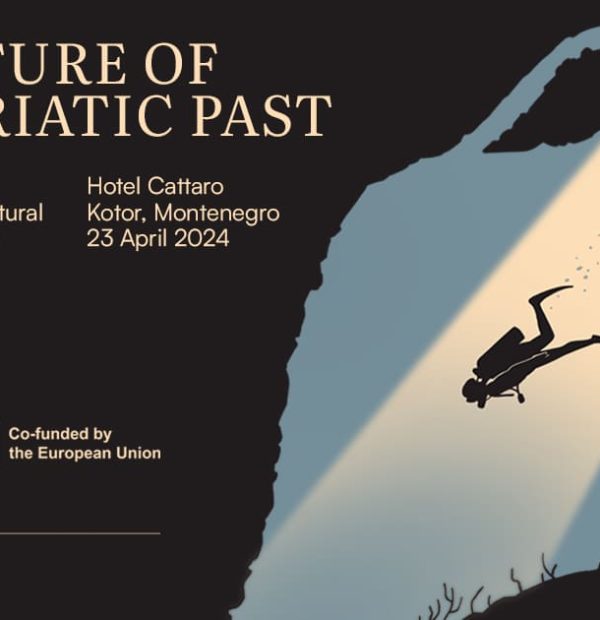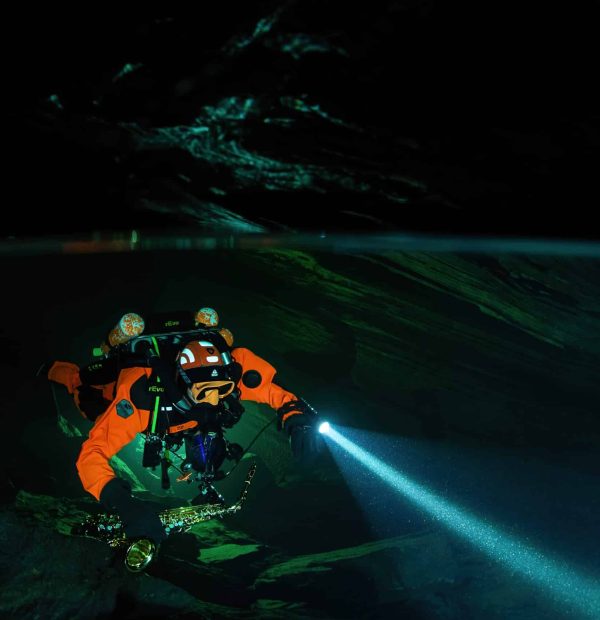Thursday, 16 May 2024
Menu

Exactly 10 years ago, at the turn of January and February 2007, together with Andrzej Szerszenie “Pszczółek” and Mirek Kopertowski, we went there to participate in an expedition organised by the Russian Geographical Society to further explore the Mcziszta cave, which lies in the Bzybski Massif adjacent to Arabia.
Mchishta was the most famous cave in the USSR. Since the mid 1970s it has been the destination of speleological expeditions from the former Soviet Union. The expeditions to Mchishta took place every year at the end of January and the beginning of February, when the air temperature ranges from zero to several degrees. Sometimes it snowed or rained, but high up in the mountains there are frosts and water from the high caves does not flow into the vents, so the hydrological conditions are more stable than in summer. The Mčiště is a large vent and in fact it is the only one draining the Bzyb Massif.
All we knew about the cave was that several kilometres of dry parts lay behind a siphon nearly 50 metres deep and 250 metres long, and that we would spend several days camping in the cave. So we had to prepare properly: Pszczółek and I went many times to the Hancza lake and other lakes to test 3-bottle sets (3×7.3l/300bar) and various containers, dry bags and other ‘airtight’ packages during dives at 50 metres depth.
We checked which ones would withstand such pressure – we had to transport through the siphon everything necessary for a few days’ existence behind the siphon and acting as caving explorers: sleeping bags, dry clothes, food, gas burners with cylinders, torches and spare batteries, speleo equipment and many other pieces of equipment. Eventually it turned out that we had a chance to transport dry sleeping bags and clothes through the siphon at that depth, using 2 dry bags stuffed one into the other and loaded with canned food and other heavy equipment.
We travelled by car to Lviv, where Ukrainian friends bought us train tickets – when bought by a local, it was cheaper than for a foreigner. The train ended in the Russian town of Adler, near the Russian-Abkhazian border. We each had a bag with a dry suit and 2 rucksacks: cave diving equipment, speleo equipment, clothes, tent, sleeping bags, carrimats, mess-tins, chargers, batteries, etc. – for 2 weeks we were going beyond any civilisation. Fortunately, we didn’t have to carry the bottles and ballast weight with us – they were to wait for us on the spot. We managed to fit all of the equipment into the “plackar” wagon, in which we spent almost 2 days – the length of the journey from Lviv to Adler.
The sleeper wagon has no compartments. It only has dividers between the individual berths – it is as if the whole carriage were one compartment with berths. During the journey we learned about travel customs in Russia, we also had to pay a bribe for excess baggage, and to Russian border guards for allegedly not putting a stamp on one of our passports.
From Adler we crossed the border by another train and then by expedition bus we reached our destination, the base of the expedition at a fish farm. We had no problems at the Abkhazian border and crossed it normally, although cavers who had travelled there before told us that not long ago guides had led them through the ‘green border’ – they had to wade in the border river away from the patrols, which cost quite a lot, dollars of course.
At the site we found quite a numerous Russian team of diving cavers. It consisted of people from all over Russia, led by “Gieneral” Yevgeny Snetkov – about 30 people in total. Andrei, whom we met six months earlier during an expedition to Crimea, was also on site. We admired the Russians’ equipment, which is unparalleled anywhere else, and interesting construction solutions of self-made products: buoyancy bags with side-mount harnesses, dual-rebreathers, watertight containers for transporting equipment underwater.
We stayed in an abandoned and devastated hotel for dignitaries. The fish farm was raising trout in special pools fed by the waters of the Mtsichta River. Like almost everything in Abkhazia it had largely fallen into disrepair and was struggling to vegetate. The hotel was on one side of the farm, and the watering hole on the other. The villa, as an old abandoned building, was devoid of all comforts and even windows, although electricity was provided for the duration of the expedition. We covered the windows with plastic, the heaters were working inside, and we put up a tent in the room we had been allocated. For water and toilets, we had to go outside, passing palm trees covered with snow at that time of the year – an interesting sight, unprecedented for me.
Along the fish farm was a creek flowing out of the Mcziszta lake. On the base there were two 300 bar combustion compressors and a number of very popular 7.3 l/300 bar cylinders produced by the tank barrel factory in Tule, as well as oxygen and helium for making breathing mixtures.
The expedition was assigned armed bodyguards by the local authorities to protect us from various thugs and subversives. We were also often visited by a farmer living nearby, Garik, who invited us to his house for “chacha” – home-made vodka. It was an interesting experience for us, I was impressed by the grave placed in the garden, which is a common custom in Abkhazia. We, in turn, were the first foreigners on the expedition for a long time.
On the day we arrived it was raining and a very strong stream of water was coming out of the cave whose opening we went to see, evoking mountain kayaking rather than diving. There were 2 divers cut off in the cave, waiting for the water level to drop. I assumed that the high water would go down for a few days, but it turned out that it was possible to dive the very next day. The water, however, had a low transparency, not exceeding 30 cm. The siphon has two entrances, from the plan it looked like you could swim directly up to the air bubble, to the 82 m deep well, to the east or west gallery – these galleries were the dry runs behind the siphon.
After getting ready, we went for a familiarisation dive in the siphon, transporting the dive equipment to the other side of the farm. The young expeditioners carried bags of cement and poured steps and platforms in front of the cave for changing – the Russians like to make their lives easier, and nature is no slouch.
We took turns diving the solo system, which worked much better than the partner system in these conditions. The corridor was wide and went down quite sharply. The water, although of low clarity, was quite warm – 10 degrees Celsius. I dived with two 7.3 l/300 bar cylinders.
At 43m depth a diver coming from the opposite direction pushed me away from the railing, depriving me of contact with it. I turned back towards the entrance and decided to first try to feel the railing, and then possibly perform the full procedure of searching for the railing with the reel – in such low visibility the chances of finding a good anchor point were not very high. So, heading upwards I used my hands to explore the bottom, the wall and possibly the ceiling, until at 37m I found a handrail and finished the dive without further adventures.
The conclusion was simple – when passing another diver, hold the railing very tightly and be close to it, even stop by sticking to the bottom. The glow of a diver swimming from the opposite direction cannot be seen from more than a few metres away.
After the adaptive dive, we assembled our 3-bottle kits, packed our belongings for the 4-day bivouac, placing them in dry bags, a special dry zip bag and under dry suits directly on top of each other, and listened to verbal instructions on which way to swim to the west gallery, where our bivouac was:
[blockquote style=”2″]”At the siphon bend at 45m there is a nib to the bubble, a thin handrail to the well at 80m and a coloured loose one to the west gallery. There will still be a departure to the right to the east gallery, so you take the left one there, watch out for a telephone cable going across it. You will be going back the other way.”[/blockquote]
Simple? Simple enough, but the standards of railing are very different from ours…
Again we swam “in line” giving ourselves a few minutes before the next person dived in. I was last. The dive was initially difficult, made more so by the positive buoyancy bag attached. However, after a few metres of clambering over the ceiling and dragging it deeper, the pressure crushed it and it became heavier with every metre.
At the bend of the siphon in the murky water I actually noticed a tangle of handrails, there were even more than the description implied. I chose the one that I thought was the right one, but after a few meters it ended up going into the sand. So I went back to the junction, chose another one and started to swim along it. At this point I got my flipper tangled in this bunch of handrails and at first I couldn’t disentangle myself. Nothing to see, 46m depth, entanglement – all this caused stress and consequently accelerated my breathing.
I thought about the fact that 3 bottles would be enough to go back and forth, but I preferred not to use too much air to have as much as possible for the return. Eventually I unhooked the fin and started to surface – here the corridor went almost vertically upwards. I was pulled out of the last 10 metres by a bag, although lower down it weighed a ton.
We emerged in the great hall and pulled the equipment a few metres above the water level, in case the water level rose. There we deposited it, making sure it was stable and would not slip on the rocks into the water, and secured it against gas leaks. We needed it again in 4 days. We had a heated discussion about the dive and it turned out that it was more mentally challenging for each of us than we had expected.
We moved to a dry, flat and spacious place not far from the siphon, where there was a camping site, and started preparing for the night: we put up a tent made from a parachute, laid out very damp mattresses and two-person sleeping bags left in a deposit from the previous team. We managed to dry them a little with torches placed in the tent, the rest we dried during the next days simply by sleeping in them.
After preparing and eating our meal we went to bed. The air temperature in the cave was 12 degrees, so it was quite warm. Over the next few days, we installed or replaced the dry railing in the cave, replacing the worn-out and makeshift clotheslines attached to half-hinges pegged into the rock with typical railing: spits, badges and 10mm ropes.
Gradually we moved deeper into the cave, exploring its parts up to the Peter the Great Siphon. The cave is vast, rich in beautiful dripstone decoration – sometimes of considerable size too – with waterfalls, lakes and rivers, which are traversed on pontoons and large inner tubes, paddling or stretching on stretched steel cables. In addition to rappelling, we helped Russian speleon divers Konstantin Kozemyakin and Dimitry Panchenko from Krasnoyarsk to transport equipment for the exploration of the third siphon in the Limpopo lateral flow – they managed to discover 400m of underwater passages up to 30m deep there.
Each “day” we would work from morning until afternoon, and then return to the bivouac where, after a meal, we would socialise with comrades from different regions of Russia. Of course, it was completely dark all the time, so when I woke up after a night’s sleep and saw such impenetrable darkness, I could immediately fall asleep and continue sleeping. It was an interesting, completely new experience for me.

On the first day we moved very cautiously, we were alert and precautionary – the result of being aware of “being behind the siphon”, from where a possible evacuation of a casualty would be extremely difficult and demanding. However, on the following days we acted as normal as usual in the cave.
There were usually about 10-12 people on the bivouac, and they changed depending on the tasks they had. A “mail diver” also arrived daily to deliver food (including fresh vegetables and pork fat that the Russians cooked at the bivouac), drinks and other items ordered the day before.
One day two enthusiastic friends emerged from our bivouac – their task was to carry the equipment from the bivouac in the east gallery to the surface, but on the way back they mistook the numerous guardrails in the siphon and instead of coming to the surface they emerged in the west gallery. They stayed the night and did not surface until the next day.
When the day came for our return, my biggest fear was choosing the wrong railing, other than the one back to the surface. Fortunately, visibility had improved and now reached 1m! Numerous boulders and sediment could be seen underwater, the railing had also been improved and the siphon’s bend was much tidier. I stuffed my bag with rocks instead of canned food and it didn’t pull upwards so much during ascent. The way back passed without adventures.
During the following days we rested. We also visited the nearby Akshasha cave, which offered a chance to connect to the Mchishta near the Peter the Great Siphon. This gave a chance to bypass the siphon and access the western gallery without diving. The Russians were working on enlarging the vertical fissures of this cave with mining methods. Already after our return to the country, it turned out that they had succeeded and added Akshasha to the Mchishta system.
In order to regenerate, we went to hot springs and on a trip to Sukhumi, the capital of Abkhazia, which bears traces of war. We also visited nearby Gudauta and the ruins of Anakopia fortress towering over the Black Sea coast. The fortress was the capital of Abkhazia in the 7th century, and the huge and beautiful Novophon cave is open to tourists.
After a few days we returned to Mčišta. Our task was to retransport the bivouac equipment and replace the initial siphon’s binding in the cave with a thick mountaineering rope fastened to the rock with spits. I was assigned the deepest point, so I took 2 cylinders for the dive and a third just for work, descended to the bottom to the siphon’s bend, found a convenient spot and after clipping the snake into the railing I spit and put on the badges moving up. The clarity continued to improve a little and now it reached 1.5m!
We also went diving in Galuboye Oziero cave, located in the Bzyb river valley. The cave was explored to over 40m deep, supposedly there was a diver further down but he drowned without leaving a sketch and the Russians didn’t know how to continue.
The cave is a beautiful spring lake, at the bottom of which a corridor develops with a railing reaching the depth of 44 m. The visibility was up to 3 m, the water was 8 degrees Celsius and there was a slight current. In the karst funnel, the walls were clayey, so it got muddy quite quickly, but in the corridor there was already solid rock.
I tied my handrail to the one left by the predecessor and moved along a straight corridor going slightly downwards. There was stone gravel at the bottom, the walls were smooth and there was nothing to rappel to. About 50m deep I reached the gas limit and just looked deep into the tempting virgin corridor, then turned around and cartwheeled the railing.
On decompression, I admired the numerous coolers and sunglasses lying on the bottom. The clay walls caused visibility to drop to zero. After surfacing, I relayed my observations to the expedition leader.
We were sad to leave the place, but it was time to go back to Poland. We agreed with the Russians on another expedition, which, however, did not take place. The expedition took place between 26.01 and 11.02 2007. Although 10 years have passed since then, it is still vivid in our memory, being a source of interesting experiences, both diving and cognitive.
Thanks to Andrew Szerszen “Bee” for recalling many interesting details of this expedition!
Photo: Mirek Kopertowski, Dominik Honzo Graczyk and Andrzej Szerszeń
Dominik Graczyk “Honzo“
SPELEOndiving, Honzo Dive
The author is an M2 KDP-CMAS instructor and passionate about cave diving and exploration of new flooded caves. He conducts, among others, PJ-1 KDP-CMAS courses and SPELEOndiving workshops, where he teaches diving techniques under the ceiling from scratch, both in the partner system and the French system. He also organises diving expeditions to less popular cave regions.










Welcome to DIVERS24.COM, your daily source of scuba news, freediving, scuba diving information, and equipment reviews. Our comprehensive coverage of the dive industry from A to Z provides you with all the latest scuba news, training updates, underwater photography tips, and everything else related to scuba diving. Whether you’re a beginner or an experienced diver looking for more knowledge about scuba gear or techniques – we’ve got it covered! With our in-depth articles written by experienced divers who have been there and done that, you are sure to find exactly what you need here at Divers24.com. Dive into scuba news today!
Underwater Media Sp. z o.o.
Szafarnia 11/F8,
80-755 Gdansk, Poland
Welcome to DIVERS24.COM, your daily source of scuba news, freediving, and scuba diving information. Sign in for a weekly news update and discount coupons for dive gear and apparel.
@2023 - underwatermedia.pl. All Right Reserved. Designed and Developed by Tworzenie stron internetowych Gdansk

The Divers24 portal is currently the largest online medium treating diving in Poland. Since 2010 we have been providing interesting and important information from Poland and around the world on all forms of diving and related activities.
Contact us: info@divers24.com